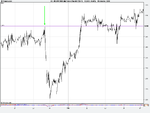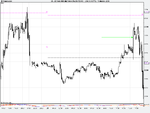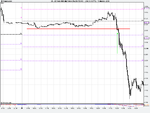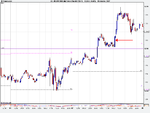You are using an out of date browser. It may not display this or other websites correctly.
You should upgrade or use an alternative browser.
You should upgrade or use an alternative browser.
Look at the chart. See the thick line? This is 2300, which on this instrument (a bucket shop version of NQ) is a big round number. These are important. If you disagree, you are an a$$hole.
Just a quick detour. There is a member of this site who has something like "If I get to 3500 posts, somebody shoot me" as his signature. He is not asking for a bullet at 3507 posts, or 3491 posts. You meet somebody at about 3, or 6.30, or around 1. You never meet people at 17.27. Every man and his dog knows it when it's two bucks to the pound. Do you think people are going to know about it if the pound-rouble and the euro-rouble get to parity? Yes. Do you think your average punter cares if it's 1.2765 to the euro? No, they don't.
That's the last discussion of round numbers. Look at the chart and see how price reacts at 2300. If you still don't get it, try looking the chart with your f***ing eyes open.
Honestly this is exactly what my trading is starting to evolve into. Horizontal S/R, trendlines, channels. I need to find a way to filter the trades so I can seperate the A trades from the B and C trades. So I'm reading up on candlestick patterns trying to recognize reversal and continuation bars.
I still overtrade and take bad setups, so I've got a lot of work to do on the "mind" part of my trading. I'll be watching this thread with interest.
worldtrader1982
Junior member
- Messages
- 13
- Likes
- 0
Hi! The world is full of traders!
I am a certified trader and have started to shine in this field several years back. I have many wonderful experiences in my trading career and I hope to have friendly discussions with all the traders in the world. I find this site amazing and I am looking forward to meet all the traders, whether novice or seasoned, to exchange views and suggestions in the trading field. I believe that through this site, we can learn a lot of trading tips and strategies that could be able to help us in our trading career.
Cheers!
Andrew Hely
I am a certified trader and have started to shine in this field several years back. I have many wonderful experiences in my trading career and I hope to have friendly discussions with all the traders in the world. I find this site amazing and I am looking forward to meet all the traders, whether novice or seasoned, to exchange views and suggestions in the trading field. I believe that through this site, we can learn a lot of trading tips and strategies that could be able to help us in our trading career.
Cheers!
Andrew Hely
andyhawes
Junior member
- Messages
- 14
- Likes
- 0
Pazienza, I just came across this post and it's excellent. It reminds me of "The Big Figure Trade" in the excellent book "Beat The Forex Dealer", which I have tried & won with a number of times.
I must write an MT4 indicator to SMS me when these are coming up and I can then trade them all without too much effort.
Keep up the great work mate! :clap:
I must write an MT4 indicator to SMS me when these are coming up and I can then trade them all without too much effort.
Keep up the great work mate! :clap:
neil
Legendary member
- Messages
- 5,169
- Likes
- 753
Hi! The world is full of traders!
I am a certified trader and have started to shine in this field several years back. I have many wonderful experiences in my trading career and I hope to have friendly discussions with all the traders in the world. I find this site amazing and I am looking forward to meet all the traders, whether novice or seasoned, to exchange views and suggestions in the trading field. I believe that through this site, we can learn a lot of trading tips and strategies that could be able to help us in our trading career.
Cheers!
Andrew Hely
Certified eh 😆
You will be in good company with Arabian and the other tormented souls on this site🙂
Pazienza
Senior member
- Messages
- 2,334
- Likes
- 442
Sorry for the long gap in posting - I haven't taken many trades, and nothing so far this week or last. So nothing in February so far - a couple that were close, including one yesterday, but not quite good enough. I'll post my last two trades and yesterdays no cigar later on tonight as they help to illustrate some reasonably important points.
First, some replies:
First, some replies:
Good thread so far.
Thank you, Senor Toast.
Although you are far too uncouth. 😉
Oh yeah, pal? F**k those who say I'm uncouth. And behead those who insult the religion of peace!
Pazienza
Senior member
- Messages
- 2,334
- Likes
- 442
Hi Pazienza,
I concur with DT's comment: good thread - but why all the effing and blinding? I can only assume you're a northerner.
😉
Re. round numbers - I've always been a fan of them - as are many traders here on T2W. Anyone who follows Mr. Charts' thread will know that he pays close attention to them. However, I suspect they're a bigger deal for stock traders than they are for futures traders. Why? Because there are far more amateur stock traders / investors than there are amateur futures traders. I doubt that pros care two hoots whether they enter / exit the market at a round number or just above or below it. They get in or out because that's what they want to do and they pay little attention to the exact number - round or not. But, as you said in your OP, this is just my view and it doesn't in any way negate your basic argument, which is well explained and as simple as you promised it would be. Good thread - keep it up!
👍
Tim.
Hi Tim,
Thank you for your comments. I can see where you're coming from, although from observation I think numbers are important on any chart. Spot forex dailies zoomed out with a big round number overlay just scream at you.
I actually also think institutions / big players might find these areas more important than smaller traders.
But in the end, perception and belief are key for all of us. In my mind, anything that we are not convinced about is useless to us. Without wanting to sound too mystical, I have no problem with your perception being different to mine, and both being right, or both being wrong. I think that goes back the necessity of finding your own way, and why it is futile to try to copy anybody else.
wow - you're not called pazienza for nothing (assuming thata means patience). How do you keep up concentration, or do you have alerts running to bring you back to the screen?
Excellent thread, as I'm leaning towards fewer and hopefully better trades. Please keep posting - I'm subscribed.
Excellent thread, as I'm leaning towards fewer and hopefully better trades. Please keep posting - I'm subscribed.
Mr. Charts
Legendary member
- Messages
- 7,370
- Likes
- 1,200
Good thread, Paz.
Pazienza
Senior member
- Messages
- 2,334
- Likes
- 442
Hey T,
hi Pazienza,
having established your method, are you going to expand upon:
1: the risk you apply to each trade, ie, is the stop loss (should you use them), beyond the tip of the pin?
Put it where the market says you were wrong. If you surmise that the tip of the pin was the turning point (the basis of your reversal play) then why would you want to be in the trade if the basis is shown to be incorrect?
That said, on some I put it some way away from the bottom / top of the entry bar, on other it would be at a point actually on the entry bar itself, as I don't feel the need to give it the whole bar as room. It depends on the situation. I always look to use my S/R flips / areas for everything, stop placement included.
There is the argument that 1 tick / pip below the pin is the obvious place for stop hunting. Fair enough, but with my trades it rarely happens. In fact, if it comes say 60% of the way down the entry bar, it's almost always over in a big way.
I very rarely take a full loss - ie, my original stop is a tight one, not a disaster one, but even so it's normally moving up quite quick. Cutting losses was a major breakthrough for me.
Risk is always the same - a fixed % of my account.
2: how you quantify the amount of return from the trade? (do you have fixed, or dynamic methods of knowing the move is exhausted)
On index futures specifically, it's very common to see a big move intraday with only minor pull-backs, which will peter out late afternoon / early evening GMT. Those days are so easy, it hurts.
Again though, I go back to s/r, RNs, flips etc. I watch to see what price does, and cash out, move stops etc. Other times, you take a quick profit at the first obvious area, maybe if you enter late in the day etc. It's entirely discretionary.
A good idea (even though it's a pain in the f***ing a$$) is to track the results of alternative exit / management methods, alongside your actual results. I can almost guarantee after a year or so the answer will be very clear (but obviously I don't know what it is as it will be different for everyone).
3: do you trade bigger if the RN pin is also coincident with a weekly or monthly strength RN?
Nope, I'm in for my % or I'm not. I aim to take fewer, better trades. If I trade bigger on certain set ups because I've shown them to be better, why trade the others? Why not wait patiently for the best and enjoy lower stress, smaller dd, lower variance.
In or out.
4:One comment you made was to "forget the move went 5R"; do then take all your profits in one go? ie, no scaling out in case of big runs?
Again, yes, in or out. My testing showed taking partial profits was costing me - really costing me. But that doesn't mean that this would apply to everyone.
thanks
Pazienza
Senior member
- Messages
- 2,334
- Likes
- 442
Fascinating thread – a system so simple that you’d be too busy trying to think of something more complicated to notice that it’s right there staring you in the face!
I’ve done some quick, visual back-testing of this on various charts and it seems to be spot-on! It’s so easy to spot once you’re ‘thinking simple’. I’m now seeing loads of support and resistance at, or very close to, big round-numbered prices, and some pretty clear price action where the big reversals take place – You don’t even need to start drawing on the chart – it’s all just there staring straight back at you.
As Trader Dante points out, S/R levels aren’t always exactly at the big rounded-numbers, but what I have observed is that, mostly, S/R occurs sufficiently close to those ‘rounded’ prices that you could easily consider those prices as the centre-points for a slightly wider S/R ‘zone’ in which to look for definitive price action.
I’m not one for buying into the concept of there being a ‘holy grail’, but this is as close as anything has come to confirming that such a thing could exist!
Thanks to Pazienza for sharing!
If it jumps at you, that's a good sign. Just be careful with eyeball back-tests - the winner jump out, but the losers hide. 🙂
Pazienza
Senior member
- Messages
- 2,334
- Likes
- 442
Get in quick then Mitch - 1300 S&P is just around the corner...
🙂
Attachments
Pazienza
Senior member
- Messages
- 2,334
- Likes
- 442
I may be new here, but this is an epic post! Keep em comin'
I am very much a numbers guy, so I look at these charts and just see so many patterns. I guess one of my biggest questions, and one that I imagine has many answers, is what makes a stock price change? I see the trades rolling through above/below/at the market/bid/ask price, but who says "this is the price of that stock"? Is there some dude (market maker or specialist) or a computer or a mix of the latest prices based on volume at each price point? I don't mean to hijack your thread, I'm just trying to understand the basis for it.
Please don't take this the wrong way, I mean it completely straight, just the way it's written.
What makes price change (stocks, futures, forex, whatever)? That is the most important question you need to ask.
Then ask what are you trying to do here. Bernanke's written a pretty good economics text book, so you're probably wasting your time getting ready to write another one.
Hopefully, you're here because you want to make more money than you lose when you trade.
So the answer to the question "What moves price?" is order flow. Now stop f***ing wondering. 🙂 Does that sound trite? Is that an annoying answer? It is the literal truth - nothing else can move price. NOTHING. It is not possible.
Working out why that order flow is there might help with writing your economics text book, but it's f*** all use for trading intra day.
This is all I do:
Look for potential areas of significant order flow. Wait to see if I get a good trigger. Trade.
No area, no trade. No trigger, no trade.
That is it.
You are a retail trader. You trade when you want. Only when you want.
Making sense?
Pazienza
Senior member
- Messages
- 2,334
- Likes
- 442
Honestly this is exactly what my trading is starting to evolve into. Horizontal S/R, trendlines, channels. I need to find a way to filter the trades so I can seperate the A trades from the B and C trades. So I'm reading up on candlestick patterns trying to recognize reversal and continuation bars.
I still overtrade and take bad setups, so I've got a lot of work to do on the "mind" part of my trading. I'll be watching this thread with interest.
Bars / candles are just a picture of price, drawn according to the parameters you set. They are NOT important in themselves.
That said, if I were you I would focus on two specifically - engulfing / outside bars and pins/ hammers / whatever the fashionable name is this week.
I like these because they contain the most information in my opinion.
Another thing - might sound stupid, but just try it. See what happens if you only take big bars.
Yep, just that. Laugh and ridicule me, then go and see how often a big bar at a good area fails to give you a chance to get to break even at least.
Pazienza
Senior member
- Messages
- 2,334
- Likes
- 442
wow - you're not called pazienza for nothing (assuming thata means patience). How do you keep up concentration, or do you have alerts running to bring you back to the screen?
Excellent thread, as I'm leaning towards fewer and hopefully better trades.
👍YES! 👍
Please keep posting - I'm subscribed.
I check in every 5 minutes on a few charts, every 15 on a few more. Not too onerous for the rewards.
Patience is hard. It is a skill I developed using a novel method like this:
I wasn't patient. Eventually I got very, very, very f***ed off with losing. I became patient. I started breaking even. I became more patient. I started winning.
Eventually, one of two things will happen. You get tired and change, or you get tired and quit.
Pazienza
Senior member
- Messages
- 2,334
- Likes
- 442
Good thread, Paz.
BEHEAD MR CHARTS!
Right, I'm caught up. Some charts, finally.
This was the last-but-one trade I took.
It's an example of a crap trade. I deserved to lose, and lose I did. That's what I like about trading - you get treated exactly as you deserve. You trade like a f***ing jerk off, you get treated like a f***ing jerk off.
No area hardly, no number, not much of a prior range, 5 minute (so my rules tell me to be extra choosy, which this was most certainly not), trading a continuation on a reversal, continued ad nauseam. Just a sh1t trade. I killed it for about a three quarters loss.
As an aside, I just got nicked in before it turned down. Look where it turned. 2330.
Attachments
Pazienza
Senior member
- Messages
- 2,334
- Likes
- 442
Now for a real beauty.
Same thing, same day.
These are the f***ing t1ts. That pin looked a lot bigger in real time before the a$$ dropped out of the market, by the way.
Fading PA out of a consolidation area with an express train behind you. Days like this you need to pinch yourself to check you're not dreaming. They happen reasonably frequently too. Feast your peeps, motherf***ers:
Same thing, same day.
These are the f***ing t1ts. That pin looked a lot bigger in real time before the a$$ dropped out of the market, by the way.
Fading PA out of a consolidation area with an express train behind you. Days like this you need to pinch yourself to check you're not dreaming. They happen reasonably frequently too. Feast your peeps, motherf***ers:
Attachments
Pazienza
Senior member
- Messages
- 2,334
- Likes
- 442
Look at that last chart again. What do you think I made on it? Even with a generous stop (actually, up towards the pivot), must be 6R, easy?
Think again motherf***er.
Let me hit you with some knowledge:
Someone posted on here not long ago that Reminiscences of a Stock Operator is an OK read, but out of date and without practical application for the modern intra day trader.
That person is an a$$hole with his head rammed up his a$$, as I will now demonstrate.
I was angry and upset with myself that I had taken a spanking on a crap trade earlier. I got this one and everything was fixed - more than fixed, I was up about 1.5 to 2 R. Now get this.
I CLOSED. For no good reason, just that I was afraid that the market would take my profit away, and the stupid loss that I took earlier would no longer be made good. I feared when I should have hoped. The relevant passages of the book were actually going through my head, and I knew I was doing wrong. But I closed anyway.
That decision cost me over 4R in lost profit (it would have been 6R had I exited according to method instead of emotion). That's over 10% of my account extra that I could have had, just by sticking to my rules.
When people say trading is primarily about patience and discipline, this is what they're talking about. The patience to wait for a good set up. The discipline to manage it according to your plan, not according to your fear, your hope, how the last trade panned out, whether you got laid that morning, or any other irrelevant sh1t.
Think again motherf***er.
Let me hit you with some knowledge:
Someone posted on here not long ago that Reminiscences of a Stock Operator is an OK read, but out of date and without practical application for the modern intra day trader.
That person is an a$$hole with his head rammed up his a$$, as I will now demonstrate.
I was angry and upset with myself that I had taken a spanking on a crap trade earlier. I got this one and everything was fixed - more than fixed, I was up about 1.5 to 2 R. Now get this.
I CLOSED. For no good reason, just that I was afraid that the market would take my profit away, and the stupid loss that I took earlier would no longer be made good. I feared when I should have hoped. The relevant passages of the book were actually going through my head, and I knew I was doing wrong. But I closed anyway.
That decision cost me over 4R in lost profit (it would have been 6R had I exited according to method instead of emotion). That's over 10% of my account extra that I could have had, just by sticking to my rules.
When people say trading is primarily about patience and discipline, this is what they're talking about. The patience to wait for a good set up. The discipline to manage it according to your plan, not according to your fear, your hope, how the last trade panned out, whether you got laid that morning, or any other irrelevant sh1t.
Last edited:
Pazienza
Senior member
- Messages
- 2,334
- Likes
- 442
Last one for tonight.
I didn't take this, but I very nearly did. Reasons should be obvious from a few posts back.
This isn't horrible in my opinion, just not that great, not really up to scratch. I'm pleased I didn't take it, even though it worked out OK. There are bigger issues at stake.
The substandard ones often work out fine. You just have to ignore that, because you know you'll leave three alone and see them scoop pips. You'll jump on the fourth and get a$$-railed. It's just the way it is.
I didn't take this, but I very nearly did. Reasons should be obvious from a few posts back.
This isn't horrible in my opinion, just not that great, not really up to scratch. I'm pleased I didn't take it, even though it worked out OK. There are bigger issues at stake.
The substandard ones often work out fine. You just have to ignore that, because you know you'll leave three alone and see them scoop pips. You'll jump on the fourth and get a$$-railed. It's just the way it is.
Attachments
Last edited:
robster970
Guest Author
- Messages
- 4,567
- Likes
- 1,390
I've been watching YM and NQ with a view to trading opportunities rather than confirmation/non-confirmation against ES and there is quite a bit of action in them isn't there my little love truncheon.
Similar threads
- Replies
- 1
- Views
- 2K
- Replies
- 11
- Views
- 3K




